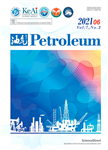Studying the effect of surfactant assisted low-salinity water flooding on clay-rich sandstones
作者机构:Department of Petroleum Engineering Amirkabir University of Technology (AUT) Department of Petroleum and Chemical Engineering College of Engineering Sultan Qaboos University
出 版 物:《Petroleum》 (油气(英文))
年 卷 期:2024年第10卷第2期
页 面:306-318页
核心收录:
学科分类:0820[工学-石油与天然气工程] 0709[理学-地质学] 070901[理学-矿物学、岩石学、矿床学] 0817[工学-化学工程与技术] 08[工学] 0815[工学-水利工程] 0703[理学-化学] 082002[工学-油气田开发工程]
主 题:Surfactant flooding Smart water Fine migration Recovery factor
摘 要:Sandstone reservoirs often contain clay particles that can cause damage and reduce permeability during low-salinity water flooding. In this study, the effect of surfactants on fine migration in clay-rich sandstones and its impact on oil recovery was ***, the impact of surfactants on interparticle forces in fine-matrix, fine-fine, and oil-matrix systems was modeled. The results showed that both CTAB(cetyltrimethyl ammonium bromide) and QS(quillaja saponin) cause EDL compaction, weakening the repulsive forces. However, SDS(sodium dodecyl sulfate)and TX(triton X-100) do not affect the EDL. Next, the effect of surfactants on IFT reduction and wettability alteration was experimentally investigated. All surfactants reduced IFT due to the surface excessive concentration mechanism. The wettability alteration experiment illustrated that although QS and CTAB compact EDL around oil and matrix particles leading to attraction force augmentation, they both alter wettability through adsorption on matrix and carboxylic groups present in crude oil, *** aqueous solutions were then injected into various clay-rich sandstone sanpacks, which resulted in increased oil recovery. However, the mechanisms leading to enhanced oil recovery variedby surfactant type. CTAB increased recovery by 10% through IFT reduction and wettability alteration, while SDS and TX increased recovery by 12% and 9%, respectively, through wettability alteration and extreme fine migration. In contrast, partial fine migration in the QS flooding experiment reached a recovery increase of 18%. Permeability trends through experiments were also recorded. During CTAB injection,permeability did not reduce, while QS aqueous solution reduced rock permeability to 5 m D. SDS and TX reduced the magnitude of permeability to 2 m *** conclusion, this study demonstrates that surfactants can effectively improve oil recovery in clay-rich sandstones by altering the interparticle forces, reducing IFT, a



